Space Probes to the Outer Planets
Outer Planet Exploration
In 1973, Pioneer 10 became the first spacecraft to visit one of the outer planets. Pioneer 10 would be the first of many spacecraft to journey beyond the asteroid belt.
Eight missions have flown to the outer planets,
including Pioneer 10 & 11,
Voyager 1 & 2,
Ulysses, Galileo,
Cassini,
and the New Horizons probe to Pluto.
The American Juno mission, the first solar powered spacecraft to visit Jupiter,
was launched in 2011 and is currently orbiting the planet.
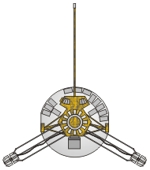

Pioneer 10 and 11
Launched during the early 1970s, Pioneer 10 and 11 were the first probes to investigate space beyond the orbit of Mars. Both spacecraft flew through the asteroid belt and performed flybys of Jupiter. Pioneer 11 went on to flyby Saturn. Both spacecraft are now on interstellar trajectories. Pioneer 10 and 11 were launched on Atlas-Centaur rockets (illustration at right).
The spacecraft were spin-stabilized at 4.8 rpm. Power was provided by a pair of Radioisotope Thermal Generators.
Pioneer 10 and 11 Instruments
Asteroid-Meteoroid Experiment
Geiger Tube Telescope
Infrared Radiometer
Trapped Radiation Detector | Cosmic Ray Telescope
Meteoroid Detector
Helium Vector magnetometer
Ultraviolet Photometer | Charged Particle Instrument
Imaging Photopolarimeter
Plasma Analyzer
|
Pioneer 11 Space Probe
| 1 | Magnetometer | 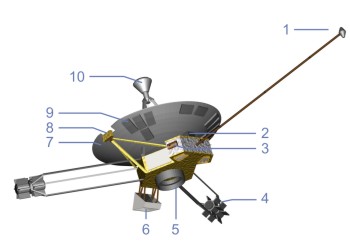 |
| 2 | Plasma Analyzer |
| 3 | Photopolarimeter |
| 4 | Radioisotope Thermal
Generators |
| 5 | Rocket Attachment Ring |
| 6 | Asteroid and Meteorite
Detector |
| 7 | High gain antenna |
| 8 | Attitude Control Thrusters |
| 9 | Meteorite Detector Panel
(1 of 12) |
| 10 | Medium Gain Antenna |
Pioneer 10 (Pioneer F)
Pioneer 10 was launched on March 2, 1972.
On December 3, 1973, Pioneer 10 encountered the planet Jupiter. Closest approach was around 200,000 km from the planet. This was the first spacecraft to investigate the largest planet in the solar system.
Pioneer 10 is currently on an interstellar trajectory and is traveling at 2.6 AU/year. The last communications with the spacecraft were made in 2003. More recent attempts at communication have failed. It is believed that the spacecraft no longer has sufficient power to operate the transmitter.
Pioneer 11 (Pioneer G)
Pioneer 11 was launched on April 5, 1973.
Pioneer 11 passed within 43,000 km of Jupiter on December 2, 1974.
On September 1, 1979, Pioneer 11 became the first spacecraft to visit Saturn. The spacecraft passed within 21,000 km of the planets atmosphere
Pioneer 11 is currently on an interstellar trajectory and is traveling at 2.5 AU/year. The last communication with Pioneer 11 was made in 1995.
Pioneer H
Pioneer H, identical to Pioneer F and G (10 and 11), served as a backup spacecraft. The mission was unflown. Pioneer H is currently on display at the National Air and Space Museum in Washington DC.
Pioneer H on display at the National Air and Space Museum
(Photos: Richard Kruse, 2008)
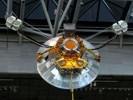




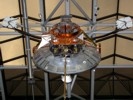
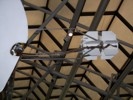
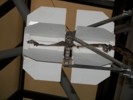
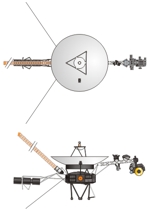
Voyager
The Mission
Voyager 1 and 2 were designed to investigate Jupiter and Saturn, their moons, and interplanetary space.
The twin Voyager spacecraft took advantage of an unusual geometric alignment of planets. This alignment would allow a single spacecraft to visit all four of the giant outer planets. Spacecraft would first encounter Jupiter, then Saturn, Uranus, and Neptune. If executed correctly, each encounter would increase the spacecrafts velocity and would bend the flight path toward the next planetary encounter.
Because their trajectory would send them out of the solar system into interstellar space, attached to each probe was a record disk. Designed to serve as time capsules, the disks contained information about Human civilization. An advanced civilization, finding the spacecraft in the distant future, could follow instruction etched into the records exterior, showing how to recover information from the disks.
The Voyager Spacecraft
The three-axis stabilized spacecraft carried a comprehensive array of scientific experiments, allowing both in-situ measurements of particles and fields, as well as remote sensing observations.
A series of remote sensing instruments, including television cameras and spectrometers, were mounted on a steerable scan platform.
Each Voyager probe was powered by three radioisotope thermoelectric generators (RTGs). The RTG's were mounted on a boom placed opposite the science boom and scan platform. Each RTG initially provided around 470 watts of 30 volt DC power. Power output has reduced as the plutonium decays over time.
Communications with Earth are made using A 3.66 m diameter parabolic high-gain antenna. A low-gain antenna is available as a backup.
A ten-sided bus, measuring 1.78 m across, forms the central part of the spacecraft. Computers, data recorders, and other equipment is located in the bus.

Launch
Each Voyager spacecraft was launched on a Titan III-E Centaur rocket (right). The Titan rockets were launched from launch complex LC-40 at Cape Canaveral Air Force Station.
Voyager 2 launched first on 20 August 1977. Voyager 1 was launched on 5 September 1977.
The Giant Planets
Voyager 1 conducted a flyby of Jupiter on 5 March 1979, and a flyby of Saturn on 12 November 1980. During its encounter with Saturn, the spacecraft conducted a close flyby of Titan. The Titan flyby forced the spacecraft out of the ecliptic plane and made future planetary flybys impossible.
Voyager 2 flew by Jupiter on 9 July 1979, and Saturn on 25 August 1981.
The Voyager probes were originally funded for the Jupiter and Saturn flybys only. Voyager 2, however, was still healthy and was on a trajectory that allowed additional planetary encounters. The probes mission was officially extended to allow flybys of both Uranus and Neptune. A flyby of Uranus was made on 24 January 1986, and Neptune was encountered on 25 August 1989. To this day, Voyager 2 is the only probe to visit Uranus and Neptune.
Beyond the Solar System
Both spacecraft are still functioning and are currently in an extended mission known as the Voyager Interstellar Mission (VIM).
Voyager Probe Photos
Voyager Probe on display at the National Air and Space Museum. (Photos: Richard Kruse, 2009)
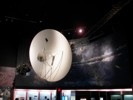
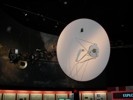
Spacecraft Bus
The spacecraft bus housed electronics and other systems.

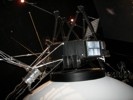
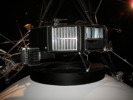

Science Boom
The science boom was around 2.5 meters in length. A steerable scan platform was mounted on the boom. The scan platform allowed instruments to be pointed at specific targets.

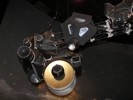
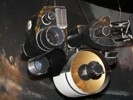

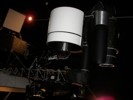
Radioisotope Thermoelectric Generator (RTG)
Voyager probes were powered by three radioisotope thermoelectric generators. Each RTG initially provided around 470 watts of 30 volt DC power. Power output has reduced as the plutonium decays over time.
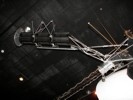
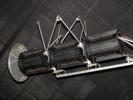
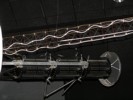
Other Details
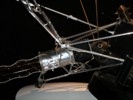
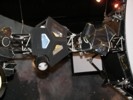
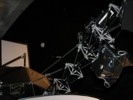


Galileo Jupiter Mission
The Mission
The Galileo probe was designed to study Jupiter, its moons, and its magnetosphere for a two year primary mission. The spacecraft included an atmospheric probe to directly study Jupiter's atmosphere.
The Galileo probe included both a spinning section and a non-spinning section. A scan platform, attached to the non-spinning section, served as a mounting point for several remote sensing experiments. Scan platform instruments included a solid state imaging camera, an ultraviolet spectrometer, a near-infrared mapping spectrometer, and a photopolarimeter radiometer.
The spinning section comprised most of the spacecraft. This section included the main propulsion system, communications equipment, several radioisotope thermoelectric generators, and computers. Fields and particles experiments, including magnetometers, were mounted in this section. The spinning section rotated at three rpm.
The spacecraft featured a large, parabolic, high gain antenna designed to facilitate high data rate communications with Earth. The antenna was initially in a collapsed configuration, similar to a closed umbrella. Engineers hoped the collapsed configuration would better protect the antenna during launch and while exposed to strong solar radiation in the inner solar system. Several low gain antennas would facilitate communication during the first years of the mission. The high gain antenna, critical to sending data from the distance of Jupiter, would be unfurled later in the mission.
The Galileo spacecraft is named for Galileo Galilei. Galileo, born on 15 February 1564 in Pisa, Italy, was a mathematician, physicist, and astronomer. Among other accomplishments, Galileo was the discoverer of Io, Europa, Ganymede, and Callisto, the four largest moons of Jupiter.
The Galileo spacecraft became the fifth space probe to visit Jupiter. Previous encounters, all flybys, included Pioneer 10 & 11, and Voyager 1 & 2.
Journey to Jupiter

Space shuttle Atlantis (STS-34), launched from Kennedy Space Center on 18 October 1989, carried the Galileo probe to orbit.
The Galileo probe was attached to a booster known as an Inertial Upper Stage, or IUS (illustration at lower right). The IUS would fire to start Galileo on its journey to Jupiter. However, the booster would not be powerful enough to send the spacecraft all the way to its destination. Gaining the necessary velocity would require several gravity assists. A trajectory known as VEEGA for Venus-Earth-Earth Gravity Assist would be used.
On two occasions, the probe was able to observe asteroids in the asteroid belt. Gaspra was encountered in October 1991, and Ida was flown-by in August 1993. The asteroid Ida was found to have a tiny moon, later named Dactyl.
A serious problem with Galileo's high gain antenna became apparent during the cruise. The antenna, designed to open like an umbrella, failed to open completely. All attempts to fully deploy the high gain antenna failed. Forced to rely on a low gain antenna for communications, the resulting data transmission rate much lower then planned.
At Jupiter
The atmospheric probe was released on July 1995, nearly five months before arrival at Jupiter. The probe, entered the planets atmosphere on 7 December 1995.
The atmospheric probe, equipped with a heat shield and parachute, collected data for nearly an hour as it descended. Data relayed from the probe provided information about the structure and composition of the upper atmosphere.
On the same day of the atmospheric probes entry, the main spacecraft fired its engines to enter orbit around Jupiter.
During the next eight years, Galileo would conduct 34 orbits of Jupiter. The trajectory was designed to allow many targeted flybys of Jupiter's moons. Specific attention was given to the four largest moons, Io, Europa, Ganymede and Callisto.
Eleven flybys of Europa were conducted. Galileo found evidence of a liquid ocean beneath an icy crust.
Designed for a two-year primary mission at Jupiter, the condition of the spacecraft allowed for several mission extensions.
End of Mission
It's mission complete, controllers sent the Galileo spacecraft plunging into Jupiter's atmosphere on 21 September 2003. Controllers wanted to ensure destruction of the spacecraft to prevent any future contamination of Jupiter's moons.
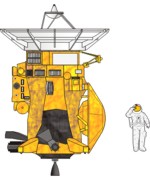

Cassini-Huygens
In 2004, Cassini became the first spacecraft to orbit Saturn. Since then, the spacecraft has conducted dozens of orbits, including many targeted flybys of Saturn's moons. Special interest has been given to the enigmatic moon, Titan. Larger then the planet Mercury, Titan has an atmosphere that some scientists believe might resemble Earth's early atmosphere. The nature of Titans surface, obscured by the thick, hydrocarbon rich, nitrogen atmosphere was a mystery before the arrival of Cassini-Huygens.
On its seven year journey to Saturn, the Cassini spacecraft carried the Huygens Titan probe. Developed and built by the European Space Agency, the Huygens probe was designed to descend trough Titans atmosphere, taking photographs and other scientific measurements. If all went well, the probe might survive landing and return data from the surface. Because little was known about the moons surface, Huygens was designed to land on either solid ground or in an ocean.
The Cassini spacecraft is named for Jean-Dominique Cassini (1625-1712). Cassini, an Italian astronomer, discovered several moons of Saturn, including Iapetus, Rhea, Tethys and Dione.
The Huygens spacecraft is named for Christiaan Huygens (1629-1695). Huygens, a Dutch astronomer, discovered the moon Titan in 1655.

The Journey to Saturn
The Cassini-Huygens spacecraft was launched on a Titan IV-B rocket (upper right) on 15 October 1997. The Titan rocket was launched from launch complex LC-40 at Cape Canaveral Air Force Station. The rocket used a Centaur-T (right) to help propel Cassini on its interplanetary journey. Powered by two RL-10 rocket engines, the Centaur-T is a high-energy, cryogenically fueled upper stage. In order to gain additional speed, the spacecraft conducted flybys of Venus, Earth, and Jupiter, en route to its July 2004 arrival at Saturn. Upon arrival, Cassini used its powerful orbital insertion engine to settle into a highly elliptical orbit around the ringed planet.
On the Surface of Titan
The Huygens probe plunged into Titans atmosphere on 14 January 2005. The descent, slowed by a parachute in the thick atmosphere, took nearly two and a half hours. Data collected by the probe was transmitted to the nearby Cassini spacecraft and relayed to Earth. Descending through the cloud deck, the probe was able to image the surface through the relatively clear lower levels of Titans atmosphere. The stunning images revealed varied terrain, including hills, dry river channels and clearly defined drainage systems.
The probe survived landing and transmitted data from the surface for 70 minutes. The probe landed on a possible dry river bed. Nearby were numerous rocks, believed to be composed of water ice.
During the descent and landing, six experiment packages recorded data for transmission to Earth. Experiments included the Aerosol Collector and Pyrolyser (ACP), Descent Imager/Spectral Radiometer (DISR), Doppler Wind Experiment (DWE), Gas Chromatograph and Mass Spectrometer (GCMS), Huygens Atmosphere Structure Instrument (HASI) and the Surface Science Package (SSP).
Photographs of Huygens Probe Model
The Huygens probe was the first spacecraft to land on Titan. These photographs are of a model at the London Science Museum. (Photos: Richard and Sharron Kruse, 2009)
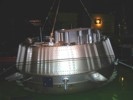



Orbiting the Ringed Planet
The heaviest outer planet probe to date, Cassini is an exceptionally capable explorer. The spacecraft is powered by three Radioisotope Thermoelectric Generators (RTGs). The three-axis stabilized spacecraft uses both reaction wheels and thrusters to control attitude. A powerful, bi-propellant, propulsion system was used for orbit insertion at Saturn and for major course changes.
Experiments on Cassini
An array of 12 scientific instruments are carried. The experiments can be divided into three categories, optical remote sensing, fields and particles, and microwave remote sensing.
Optical Remote Sensing Instruments
These instruments produce images, both in visible light and other parts of the electromagnetic spectrum.
- Composite Infrared Spectrometer (CIRS)
- Imaging Science Subsystem (ISS)
- Ultraviolet Imaging Spectrograph (UVIS)
- Visible and Infrared Mapping Spectrometer (VIMS)
Fields and Particles Instruments
These devices measure characteristics of the environment the spacecraft is flying through. Things such as magnetic fields, plasma, and dust concentrations are measured.
- Cassini Plasma Spectrometer (CAPS)
- Cosmic Dust Analyzer (CDA)
- Ion and Neutral Mass Spectrometer (INMS)
- Magnetometer (MAG)
- Magnetospheric Imaging Instrument (MIMI)
- Radio and Plasma Wave Science (RPWS)
Microwave Remote Sensing
Using radio waves, the following experiments can measure characteristics of Titans atmosphere and the structure of Saturn's rings. The radar, easily penetrating Titans thick atmosphere, can reveal topographic information of the moons surface.
Exploration Continues
The nearly flawless Cassini mission has returned a virtual flood of data on Saturn and her moons. Titan, once shrouded in mystery, now seems like a real world. A world that, in some ways, is not much different from our own. A world that we are sure to explore further in the future.
Recently extended to 2017, the Cassini mission will continue to expand our knowledge of the Saturn system for years to come.
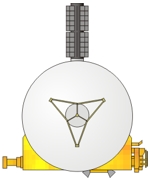

New Horizons
The Mission
Launched on 19 January 2006, the New Horizons mission is currently in route to a flyby of Pluto and its moon, Charon.
Power is provided by a radioisotope thermoelectric generator (RTG).
Journey to Pluto
The mission launched on an Atlas-V (551) rocket from launch complex 41 at Cape Canaveral. The launch included a Centaur second stage, and a STAR 48B solid rocket third stage.
To gain additional speed, the spacecraft performed a gravity assist flyby of Jupiter in 2006.
The probe will arrive at Pluto in 2015. If the spacecraft remains healthy, an extended mission may include one or more flybys of Kuiper belt objects.
Photos of a New Horizons Mockup
These photographs are of a full-size model on display at the Udvar Hazy Center. (Photos: Richard Kruse, 2009)
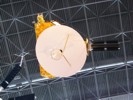


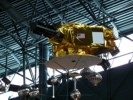
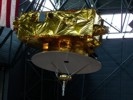
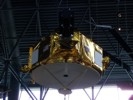
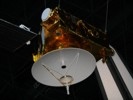
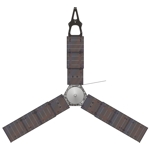

Juno
The Mission
The Juno spacecraft, currently orbiting Jupiter, uses a suite of instruments to probe the planets internal structure, composition and magnetosphere.
Scientists will use this information to better understand the origins of the gas giant.
Juno is the ninth mission to encounter Jupiter.
Previous encounters include Pioneer 10 & 11, Voyager 1 & 2, Ulysses, Galileo, Cassini, and the New Horizons probe to Pluto.
The Spacecraft
Unique amongst outer planet probes, Juno is solar powered.
All previous missions flown to Jupiter and beyond have relied on plutonium fueled, radioisotope thermoelectric generators to provide electrical current.
Jupiter orbits the Sun approximately five times as distant as the Earth.
Because sunlight at Jupiter is only 1/25 as strong as near the Earth, Juno includes relatively large solar arrays.
Launch and Cruise
Juno was launched in August, 2011 from Cape Canaveral Air Force Station in Florida.
The launch vehicle was an Atlas V-551 rocket.
The long cruise to Jupiter took around five years and included a gravity-assist Earth flyby in October 2013.
Arrival
Juno entered orbit around Jupiter in July, 2016.
At Jupiter, the spacecraft entered a highly elliptical polar orbit.
Because Jupiter will be rotating, the 33 planned orbits will allow instruments on the spacecraft to investigate the entire surface of the planet.
Juno is planned to orbit Jupiter for a little over a year.
Upon conclusion of its mission, the spacecraft will be deliberately crashed into the giant planet's atmosphere.
Mission planners want to ensure the spacecrafts destruction to avoid any future contamination of Jupiter's moons.
References
R. Fimmel, W. Swindell, and E. Burgess, Pioneer Odyssey, NASA SP-349. 1977.
M. Meltzer, Mission to Jupiter: The History of the Galileo Project, NASA SP-4231. 2007.
R. Batson, Voyager 1 and 2 Atlas of Six Saturnian Satellites, NASA SP-474. 1984.
 Images by Richard Kruse are licensed under a Creative Commons Attribution-Noncommercial 3.0 United States License.
Images by Richard Kruse are licensed under a Creative Commons Attribution-Noncommercial 3.0 United States License.


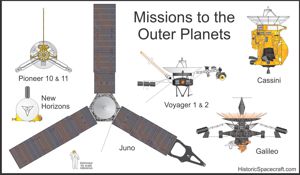















































 Images by Richard Kruse are licensed under a Creative Commons Attribution-Noncommercial 3.0 United States License.
Images by Richard Kruse are licensed under a Creative Commons Attribution-Noncommercial 3.0 United States License.